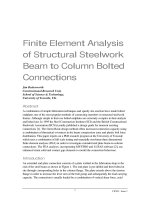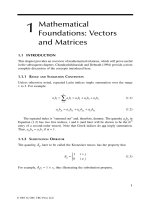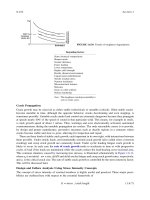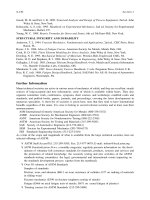Finite Element Analysis - Thermomechanics of Solids Part 11 pps
Bạn đang xem bản rút gọn của tài liệu. Xem và tải ngay bản đầy đủ của tài liệu tại đây (570.95 KB, 13 trang )
153
Solution Methods
for Linear Problems
11.1 NUMERICAL METHODS IN FEA
11.1.1 S
OLVING
THE
F
INITE
-E
LEMENT
E
QUATIONS
: S
TATIC
P
ROBLEMS
Consider the numerical solution of the linear system
Kγγ
γγ
=
f
, in which
K
is the
positive-definite and symmetric stiffness matrix. In many problems, it has a large
dimension, but is also banded. The matrix can be “triangularized”:
K
=
LL
T
, in
which
L
is a lower triangular, nonsingular matrix (zeroes in all entries above the
diagonal). We can introduce
z
=
L
T
γγ
γγ
and obtain
z
by solving
Lz
=
f
. Next, γγ
γγ
can be
computed by solving
L
T
γγ
γγ
=
z
. Now
Lz
=
f
can be conveniently solved by forward
substitution. In particular,
Lz
=
f
can be expanded as
(11.1)
Assuming that the diagonal entries are not too small, this equation can be solved,
starting from the upper-left entry, using simple arithmetic:
z
1
=
f
1
/
l
11
,
z
2
=
[
f
2
−
l
21
z
1
]
/
l
22
,
z
3
=
[
f
3
−
l
31
z
1
−
l
32
z
2
]
/
l
33
,
…
.
Next, the equation
L
T
γγ
γγ
=
z
can be solved using backward substitution. The
equation is expanded as
(11.2)
11
l
ll
lll
ll l
z
z
z
z
f
f
f
f
nn nnn n
11
21 22
31 32 33
12
1
2
3
1
2
3
00
0
.
.
.
.
.
=
.
ll l
l
lll
ll
l
n
nn nn nn
nn nn
nn n
11 12 1
22
22 21 2
11 1
1
2
3
0
00
0
00 0 0
.
. .
. .
.
.
.
,,,
,,
−− −− −
−− −
γ
γ
γ
γ
=
−
−
f
f
f
f
n
n
n
1
2
1
.
.
.
0749_Frame_C11 Page 153 Wednesday, February 19, 2003 5:13 PM
© 2003 by CRC CRC Press LLC
154
Finite Element Analysis: Thermomechanics of Solids
Starting from the lower-right entry, solution can be achieved using simple arith-
metic as
γ
n
=
f
n
/
l
nn
,
In both procedures, only one unknown is encountered in each step (row).
11.1.2 M
ATRIX
T
RIANGULARIZATION
AND
S
OLUTION
OF
L
INEAR
S
YSTEMS
We next consider how to triangularize
K
. Suppose that the upper-left (
j
−
1)
×
(
j
−
1) block
K
j
−
1
has been triangularized: In determining whether the
j
×
j
block
K
j
can be triangularized, we consider
(11.3)
in which
k
j
is a (
j
−
1)
×
1 array of the first
j
−
1 entries of the
j
th
column of
K
j
.
Simple manipulation suffices to furnish
k
j
and
l
jj
.
(11.4)
Note that λλ
λλ
j
can be conveniently computed using forward substitution. Also,
note that
l
jj
=
The fact that
K
j
>
0 implies that
l
jj
is real. Obviously,
the triangularization process proceeds to the (
j
+
1)
st
block and on to the complete
stiffness matrix.
As an example, consider
(11.5)
Clearly, For the second block,
(11.6)
γγγ γγ
n n n nnn n n nnn nn n nn
fl l fl l l
−−− −−− −− −−−−−
=− =− −
1111112 22 21122
[]/,[ ]/, .
,, , , ,
K
KLL
T
jjj−−−
=
111
.
K
Kk
kk
L0
L
0
T
T
T
T
j
jj
jjj
j
jjj
jj
jj
l
l
=
=
−
−
−
1
1
1
λλ
λλ
,
k
jjj
jj jj j j
lk
=
=−
−
L
T
1
λλ
λλλλ
k
jj j j j
−
−
−
kk
T1
K
1
.
A
3
=
1
1
2
1
3
1
2
1
3
1
4
1
3
1
4
1
5
.
LL
11
T
=→1.
10
1
0
1
222
2
22
1
2
1
2
1
3
λ
λ
l
l
=
,
0749_Frame_C11 Page 154 Wednesday, February 19, 2003 5:13 PM
© 2003 by CRC CRC Press LLC
Solution Methods for Linear Problems
155
from which
λ
2
=
1/2 and Now
(11.7)
We now proceed to the full matrix:
(11.8)
We conclude that
l
31
=
1/3, l
32
= = 1/5 − 1/9 − 1/12 =
11.1.3 TRIANGULARIZATION OF ASYMMETRIC MATRICES
Asymmetric stiffness matrices arise in a number of finite-element problems, includ-
ing problems with unsteady rotation and thermomechanical coupling. If the matrix
is still nonsingular, it can be decomposed into the product of a lower-triangular and
an upper-triangular matrix:
(11.9)
Now, the j
th
block of the stiffness matrix admits the decomposition
(11.10)
in which it is assumed that the ( j − 1)
th
block has been decomposed in the previous
step. Now, u
j
is obtained by forward substitution using L
j−1
u
j
= k
1j
, and
λλ
λλ
j
can be
obtained by forward substitution using Finally, for
l
22
2
13 12 1 12=− =/(/) / .
L
2
10
12 1 12
=
//
.
1
100
112 0
1
0112
00
1
212
2
1
2
1
3
1
2
1
3
1
4
1
3
1
4
1
5
33
1
2
31 32 33
1
2
31
32
33
1
2
31
1
2
1
3
31 32
31 31
=
=
=+
+
LL
T
//
//
/
lll
l
l
l
l
ll
ll
lllll
32 31
2
32
2
33
2
12/ ++
112/,l
33
2
1
180
.
KLU= .
K
Kk
k
L0
U
0
LU L
U
T
T
T
TT
j
jj
jjj
j
jjj
jj
jj
jj jj
j j j j jj jj
k
l
l
=
=
=
+
−
−
−
−− −
−
11
2
1
1
11 1
1
λλ
λλλλ
u
u
u
u u
Uk
T
jj j−
=
12
λλ
.
uu
jj jj jj j j
lk=−
λλ
T
,
0749_Frame_C11 Page 155 Wednesday, February 19, 2003 5:13 PM
© 2003 by CRC CRC Press LLC
156 Finite Element Analysis: Thermomechanics of Solids
which purpose u
jj
can be arbitrarily set to unity. An equation of the form Kx = f can
now be solved by forward substitution applied to Lz = f, followed by backward
substitution applied to Ux = z.
11.2 TIME INTEGRATION: STABILITY AND ACCURACY
Much insight can be gained from considering the model equation:
(11.11)
in which
λ
is complex. If Re(
λ
) > 0, for the initial value y(0) = y
0
, y(t) = y
0
exp(−
λ
t),
then clearly y(t) → 0. The system is called asymptotically stable in this case.
We now consider whether numerical-integration schemes to integrate Equation
11.11 have stability properties corresponding to asymptotic stability. For this pur-
pose, we apply the trapezoidal rule, the properties of which will be discussed in a
subsequent section. Consider time steps of duration h, and suppose that the solution
has been calculated through the n
th
time step, and we seek to compute the solution at
the (n + 1)
st
time step. The trapezoidal rule is given by
(11.12)
Consequently,
(11.13)
Clearly, y
n+1
→ 0 if < 1, and y
n+1
→ ∞ if > 1, in which |·| implies
the magnitude. If the first inequality is satisfied, the numerical method is called A-stable
(see Dahlquist and Bjork, 1974). We next write
λ
=
λ
r
+ i
λ
i
, and now A-stability
requires that
(11.14)
A-stability implies that
λ
r
> 0, which is precisely the condition for asymptotic
stability.
Consider the matrix-vector system arising in the finite-element method:
(11.15)
dy
dt
y=−
λ
,
dy
dt
yy
h
yyy
nn
nn
≈
−
−≈− +
+
+
1
1
2
,[].
λ
λ
y
h
h
y
h
h
y
nn
n
+
=
−
+
=
−
+
1
0
12
12
12
12
λ
λ
λ
λ
/
/
/
/
12
12
−
+
λ
λ
h
h
/
/
12
12
−
+
λ
λ
h
h
/
/
1
1
1
22
22
2
2
2
2
−+
++
<
λ
λ
λ
λ
r
h
i
h
r
h
i
h
.
MDK0
˙˙ ˙
,(
˙
(
˙
,γγγγγγγγγγγγγγ++= = = 0 , 0))
00
0749_Frame_C11 Page 156 Wednesday, February 19, 2003 5:13 PM
© 2003 by CRC CRC Press LLC
Solution Methods for Linear Problems 157
in which M, D, and K are positive-definite. Elementary manipulation serves to derive
that
(11.16)
It follows that and γγ
γγ
→ 0. We conclude that the system is asymptotically
stable.
Introducing the vector the n-dimensional, second-order system is written
in state form as the (2n)-dimensional, first-order system of ordinary differential
equations:
(11.17)
We next apply the trapezoidal rule to the system:
(11.18)
From the equation in the lower row, p
n+1
= [γγ
γγ
n+1
− γγ
γγ
n
] − p
n
. Eliminating p
n+1
in the upper row furnishes a formula underlying the classical Newmark method:
(11.19)
and K
D
can be called the dynamic stiffness matrix. Equation 11.19 can be solved
by triangularization of K
D
, followed by forward and backward substitution.
11.3 NEWMARK’S METHOD
To fix the important notions, consider the model equation
(11.20)
Suppose this equation is modeled as
(11.21)
d
dt
1
2
1
2
˙˙ ˙˙
.γγγγγγγγγγγγ
TT T
MK D0+
=− <
˙
γγ→0
p =
˙
,γγ
M0
0I
p
DK
I0
p
f
0
+
−
=
•
γγγγ
.
M0
0I
pp
DK
I0
pp
ff
0
−
−
+
−
+
+
=
+
+
+
+
+
+
1
1
1
2
1
2
1
2
1
1
1
1
1
h
h
nn
nn
nn
nn
nn
()
()
()
()
()
.
γγγγγγγγ
2
h
KrKMDK
rMDK MDp ff
DD
γγ
nn
nnnnn
hh
hh
y
hh h
++
+ +
==++
=+ −
++
++
11
2
1
22
1
24
24 22 4
,
()
dy
dx
fy= ().
αβ γδ
yyhff
nnnn++
++ +=
11
0[].
0749_Frame_C11 Page 157 Wednesday, February 19, 2003 5:13 PM
© 2003 by CRC CRC Press LLC
158 Finite Element Analysis: Thermomechanics of Solids
We now use the Taylor series to express y
n+1
and f
n+1
in terms of y
n
and f
n
. Noting
that and we obtain
(11.22)
For exact agreement through h
2
, the coefficients must satisfy
(11.23)
We also introduce the convenient normalization
γ
+
δ
= 1. Simple manipulation
serves to derive that
α
= −1,
β
= 1,
γ
= 1/2,
δ
= 1/2, thus furnishing
(11.24)
which can be recognized as the trapezoidal rule.
The trapezoidal rule is unique and optimal in having the following three char-
acteristics:
It is a “one-step method” using only the values at the beginning of the current
time step.
It is second-order-accurate; it agrees exactly with the Taylor series through h
2
.
Applied to dy/dt +
λ
y = 0, with initial condition y(0) = y
0
, it is A-stable
whenever a system described by the equation is asymptotically stable.
11.4 INTEGRAL EVALUATION BY
GAUSSIAN QUADRATURE
There are many integrations in the finite-element method, the accuracy and efficiency
of which is critical. Fortunately, a method that is optimal in an important sense,
called Gaussian quadrature, has long been known. It is based on converting physical
coordinates to natural coordinates. Consider Let
ξ
= [2x − (a + b)].
Clearly,
ξ
maps the interval [a, b] into the interval [−1,1]. The integral now becomes
Now consider the power series
(11.25)
from which
(11.26)
The advantages illustrated for integration on a symmetric interval demonstrate that,
with n function evaluations, an integral can be evaluated exactly through (2n − 1)
st
order.
′
=yf
nn
′′
=
′
yf
nn
,
02
2
=+
′
+
′′
++
′
+
′′
+
′
αβγδ
[/][].yyhyh yhyyhhy
nn n n nn n
αβ αγδ α γ
+= ++= +=000 2/.
yy
h
fy fy
nn
nn
+
+
−
=+
1
1
1
2
[()()],
∫
a
b
fxdx() .
1
ba−
1
1
1
ba
fd
−
∫
−
() .
ξξ
f ()
01 2
2
3
3
4
45
ξααξαξαξαξαξ
=+ + + + + +
5
L,
fd(.
ξξ α α α
)20
2
3
0
2
5
0
1
1
13
5
−
∫
=++ ++ ++L
0749_Frame_C11 Page 158 Wednesday, February 19, 2003 5:13 PM
© 2003 by CRC CRC Press LLC
Solution Methods for Linear Problems 159
Consider the first 2n − 1 terms in a power-series representation for a function:
(11.27)
Assume that n integration (Gauss) points
ξ
i
and n weights are used as follows:
(11.28)
Comparison with Equation 11.26 implies that
(11.29)
It is necessary to solve for n integration points,
ξ
i
, and n weights, w
i
. These are
universal quantities. To integrate a given function, g(
ξ
), exactly through
ξ
2n−i
, it is
necessary to perform n function evaluations, namely to compute g(
ξ
i
).
As an example, we seek two Gauss points and two weights. For n = 2,
(11.30)
From (ii) and (iv), leading to
ξ
2
= −
ξ
1
. From (i) and (iii), it
follows that −
ξ
2
=
ξ
1
= The normalization w
1
= 1 implies that w
2
= 1.
11.5 MODAL ANALYSIS BY FEA
11.5.1 M
ODAL DECOMPOSITION
In the absence of damping, the finite-element equation for a linear mechanical
system, which is unforced but has nonzero initial values, is described by
. (11.31)
Assume a solution of the form which furnishes upon substitution
(11.32)
The j
th
eigenvalue,
λ
j
, is obtained by solving and a corre-
sponding eigenvector vector, γγ
γγ
j
, can also be computed (see Sample Problem 2).
g
n
n
(.
ξααξ αξ
)
12 2
21
=+ ++
−
L
gd g w w w w
ii
i
n
i
i
n
ii
i
n
nii
n
i
n
(( .
ξξ ξ α α α α ξ
))
1
1
1
12
1
2
1
−
===
−
=
∫
∑∑∑ ∑
==+++
1
21
L
ww w w
n
w
i
i
n
i
i
n
ii
i
n
ii
n
i
n
ii
n
i
n
== =
−
=
−
=
∑∑ ∑ ∑ ∑
== = =
−
=
11
2
1
22
1
21
1
10 23
2
21
0,, /,, , .
ξξ ξ ξ
K
ww w w
ww ww
12 1122
11
2
22
2
11
3
22
3
20
2
3
0
+= + =
+= +=
(i), (ii)
(iii), (iv)
ξξ
ξξ ξξ
w
11 1
2
2
2
0
ξξ ξ
[],−=
1/ 3.
MK0
˙˙
,( ,
˙
(
˙
γγγγγγγγγγγγ+= = = 00
00
))
γγγγ =
ˆ
(),exp t
λ
[]
ˆ
.KM0+=
λ
2
γγ
det( ) ,KM+=
λ
j
2
0
0749_Frame_C11 Page 159 Wednesday, February 19, 2003 5:13 PM
© 2003 by CRC CRC Press LLC
160 Finite Element Analysis: Thermomechanics of Solids
For the sake of generality, suppose that
λ
j
and γγ
γγ
j
are complex. Let denote the
complex conjugate (Hermitian) transpose of γγ
γγ
j
. Now, satisfies
.
Since M and K are real and positive-definite, it follows that
λ
j
is pure imaginary:
λ
j
= i
ω
j
. Without loss of generality, we can take γγ
γγ
j
to be real and orthonormal.
Sample Problem 1
As an example, consider
(11.33)
Now det[K +
λ
2
I] = 0 reduces to
(11.34)
with the roots
(11.35)
so that both are negative (since k
11
and k
22
are positive).
We now consider eigenvectors. The eigenvalue equations for the i
th
and j
th
eigenvectors are written as
(11.36)
It is easily seen that the eigenvectors have arbitrary magnitudes, and for conve-
nience, we assume that they have unit magnitude Simple manipulation
furnishes that
(11.37)
γγ
j
H
λ
j
2
λ
j
jj
jj
2
=−
γγγγ
γγγγ
H
H
K
M
MK=
=
10
01
11 12
12 22
kk
kk
.
() [ ] [ ] ,
λλ
22
11 22
2
11 22 12
2
0++ + +=kk kk k
λ
+−
=− + ± + − +
[]
=− + ± − −
[]
,
[][][ ]
[][]
2
11 22 11 22
2
11 22 12
2
11 22 11 22
2
12
2
1
2
4
1
2
4
kk kk kkk
kk kk k
λλ
+−
22
and
[[KM 0 KM 0+= +=
ωω
jj
kk
22
]g g ]
γγγγ
jj
T
= 1.
γγγγγγγγγγγγγγγγ
k
jj
k
j
k
j
k
j
k
TT T T
KK M M−− − =[].
ωω
22
0
0749_Frame_C11 Page 160 Wednesday, February 19, 2003 5:13 PM
© 2003 by CRC CRC Press LLC
Solution Methods for Linear Problems 161
Symmetry of K and M implies that
(11.38)
Assuming for convenience that the eigenvalues are all distinct, it follows that
(11.39)
The eigenvectors are thus said to be orthogonal with respect to M and K. The
quantities and are called the ( j
th
) modal mass and ( j
th
)
modal stiffness.
Sample Problem 2
Consider
(11.40)
Let For the determinant to vanish,
Using the first eigenvector satisfies
(11.41)
implying that The corresponding procedures for the sec-
ond eigenvalue furnish that It is readily verified that
(11.42)
The modal matrix X is now defined as
(11.43)
γγγγγγγγγγγγγγγγγγγγ
k
jj
k
j
k
j
k
j
k
j
kk
j
TT T T T
KK M M M−= − =− =00
22 22
,[ ( ) . ]
ωω ωω
γγγγγγγγ
j
k
j
k
jk
TT
MK==≠00,,.
µ
jjj
=γγγγ
T
M
κ
jjj
=γγγγ
T
K
20
01
21
11
0
0
1
2
1
2
+
−
−
=
••
γ
γ
γ
γ
k
m
.
ζωωω
22
0
2
0
2
==
j
km/, /
.
112
2
−=±
±
ζ
/
.
112
2
−=
±
ζ
/,
21
112
0
0
1
1
1
2
1
1
1
2
2
1
2
−
−
=
[]
+
[]
=
/
,,
()
()
() ()
γ
γ
γγ
γ
γ
1
1
2
1
13 2 3
() ()
/, /.==
γγ
1
2
2
2
13 2 3
() ()
/, /.==−
γγγγγγγγ
γγγγγγγγ
( ) () () ( )
( ) () () ( )
,/, /,
, [ /], [ /]
2112
12
2112
12
043 43
0
4
3
112
4
3
112
TT
TT
MM
KK
=== =
= = =− =+
µµ
κκ
X = [].γγγγγγγγ
123
L
n
0749_Frame_C11 Page 161 Wednesday, February 19, 2003 5:13 PM
© 2003 by CRC CRC Press LLC
162 Finite Element Analysis: Thermomechanics of Solids
Since the jk
th
entries of X
T
MX and X
T
KX are and respectively,
it follows that
(11.44)
The modal matrix is said to be orthogonal with respect to M and K, but it is
not purely orthogonal since X
−1
≠ X
T
.
The governing equation is now rewritten as
(11.45)
implying the uncoupled modes
(11.46)
Suppose that g
j
(t) = g
j0
sin (
ω
t). Neglecting transients, the steady-state solution
for the j
th
mode is
(11.47)
It is evident that if (resonance), the response amplitude for the
j
th
mode is much greater than for the other modes, so that the structural motion under
this excitation frequency illustrates the mode. For this reason, the modes can easily
be animated.
11.5.2 COMPUTATION OF EIGENVECTORS AND EIGENVALUES
Consider with Many methods have been proposed to
compute the eigenvalues and eigenvectors of a large system. Here, we describe a
method that is easy to visualize, which we call the hypercircle method. The vectors
Kγγ
γγ
j
and Mγγ
γγ
j
must be parallel to each other. Furthermore, the vectors
and must terminate at the same point in a hypersphere in n-
dimensional space. Suppose that is the
ν
th
iterate and that the two vectors
γγγγ
j
k
T
M γγγγ
j
k
T
K ,
XMX XKX
TT
=
=
µ
µ
µ
κ
κ
κ
1
2
1
2
0
0
0
0
.
.
.
.
.
nn
X MX X KX g X g X f
TT 1 T
˙˙
,,,ξξξξξξγγ+== =
−
µξ κξ
jj jj j
gt
˙˙
().+=
ξ
κωµ
ω
j
j
jj
g
t=
−
0
2
sin( ).
ωωκµ
22
~/
jjj
=
KMγγγγ
jjj
=
ω
2
, γγγγ
jj
T
= 1.
KK
T
γγ γ
jj j
/
2
MM
T
γγ γ
jj j
/
2
γγ
j
()
ν
0749_Frame_C11 Page 162 Wednesday, February 19, 2003 5:13 PM
© 2003 by CRC CRC Press LLC
Solution Methods for Linear Problems 163
do not coincide in direction. Another iterate can be attained by an interval-halving
method:
(11.48)
Alternatively, note that
(11.49)
is the cosine of the angle between two unit vectors, and as such it assumes the
maximum value of unity when the vectors coincide. A search can be executed on
the hypersphere in the vicinity of the current point, seeking the path along which C(γγ
γγ
j
)
increases until the maximum is attained.
Once the eigenvector γγ
γγ
j
is found, the corresponding eigenvalue is found from
Now, an efficient scheme is needed to “deflate” the system
so that and γγ
γγ
1
no longer are part of the eigenstructure in order to ensure that the
solution scheme does not converge to values that have already been calculated.
Given γγ
γγ
1
and we can construct a vector p
2
that is M-orthogonal to γγ
γγ
1
by
using an intermediate vector Clearly,
However, p
2
is also clearly orthogonal to Kγγ
γγ
1
since it is collinear with Mγγ
γγ
1
. A similar procedure leads to vectors p
j
, which are orthog-
onal to each other and to Mγγ
γγ
1
and Kγγ
γγ
1
. For example, with p
2
set to unit magnitude,
Now,
Introduce the matrix X
1
as follows: X
1
= [γγ
γγ
1
p
2
p
3
…
p
n
]. For the k
th
eigen-
value, we can write
(11.50)
which decomposes to
(11.51)
This implies the “deflated” eigenvalue problem
(11.52)
The eigenvalues of the deflated system are also eigenvalues of the original system.
The eigenvector ηη
ηη
n−1
can be used to compute the eigenvectors of the original system
M
M
M
K
K
M
T
ˆ
,
ˆˆ ˆ
.
()
()
() ()
()
() ()
() () () ()
γγ
γγ
γγγγ
γγ
γγ
γγγγγγγγ
γγ
j
j
jj
j
jj
jj j j
TT
ν
ν
νν
ν
νν
νν ν ν
+++++
=+
=
1
22
11 121
1
2
C(γγ
γγ
γγγγ
γγ
γγγγ
j
j
jj
j
jj
) =
T
TT
K
K
M
M
22
ω
j
2
= ()/( ).γγγγγγγγ
jjj j
TT
KM
ω
1
2
,
ω
1
2
,
ˆ
:
ˆˆ
.pp p Mp
T
22 21 21
=−γγγγ
γγγγ
1212
TT
Mp Mp=−
ˆ
γγγγγγ
1211 1
01
TT
Mp M
ˆ
.==assuming
µ
p
3
=
ˆˆ ˆ
.pppp Mp
TT
32321 31
−−γγγγ pp Mp
TT
23 1 3
00== and γγ
ˆ
.
XKX XMX X 0
TT1
11
2
111
−
[]
=
−
ωωγγ
kk
,
ω
ω
1
2
1
2
1
1
1
0
0
0
0K
0
0M
0
T
T
˜
˜
.
n
k
n
n
−
−
−
−
=
ηη
[
˜˜
].KM 0
n
k
nn−−−
−=
111
ω
ηη
0749_Frame_C11 Page 163 Wednesday, February 19, 2003 5:13 PM
© 2003 by CRC CRC Press LLC
164 Finite Element Analysis: Thermomechanics of Solids
using transformations involving the matrix X
1
. The eigenvalues and eigenvectors of
the deflated system can be computed by, for example, the hypercircle method
described previously.
11.6 EXERCISES
1. Verify that the triangular factors L
3
and for A
3
in Equation 11.5 are correct.
2. Using A
3
in Equation 11.5, use forward substitution followed by backward
substitution to solve
3. Triangularize the matrix
4. For the model equation dy/dx = f(y), develop a two-step numerical-integration
model:
What is the order of the integration method (highest power in h with exact
agreement with the Taylor series)?
5. Find the integration (Gauss) points and weights for n = 3.
6. In the damped linear-mechanical system
suppose that γγ
γγ
(t) = γγ
γγ
n
at the n
th
time step. Derive K
D
and r
n+1
such that γγ
γγ
at the (n + 1)
st
time step satisfies
7. For the linear system
triangularize the matrix and solve for
γ
1
,
γ
2
,
γ
3
.
L
T
3
A
3
γγ=
1
1
1
.
K =
36 30 18
30 41 23
18 23 14
.
( ) [ ( ) ( ) ( )] .
αβγ δ ε ζ
y y y h fy fy fy
nnn n n n+−+ −
++ + + + =
111 1
0
MDKf
˙˙ ˙
(),γγγγγγ++=t
Kr
D
γγ
nn++
=
11
.
36 30 24
30 41 32
24 32 27
1
2
3
1
2
3
=
γ
γ
γ
0749_Frame_C11 Page 164 Wednesday, February 19, 2003 5:13 PM
© 2003 by CRC CRC Press LLC
Solution Methods for Linear Problems 165
8. (a) Find the modal masses
µ
1
,
µ
2
and the modal stiffnesses
κ
1
and
κ
2
of
the system
(b) Determine the steady-state response of the system (i.e., particular
solution to the equation).
9. Triangularize
10. Put the following equations in state form, apply the trapezoidal rule, and
triangularize the ensuing dynamic stiffness matrix:
3
10
02
27
11
12
10
20
10
1
2
1
2
+
−
−
=
()
••
γ
γ
γ
γ
sin .t
20
04 2
20
2
µ
µµ
µ
AL A
AL Y A L
AAL
/
//
/
.
−
−
MK f 0
T
˙˙
,
.
γγγγΣΣππΣΣγγ+−= =
0749_Frame_C11 Page 165 Wednesday, February 19, 2003 5:13 PM
© 2003 by CRC CRC Press LLC









